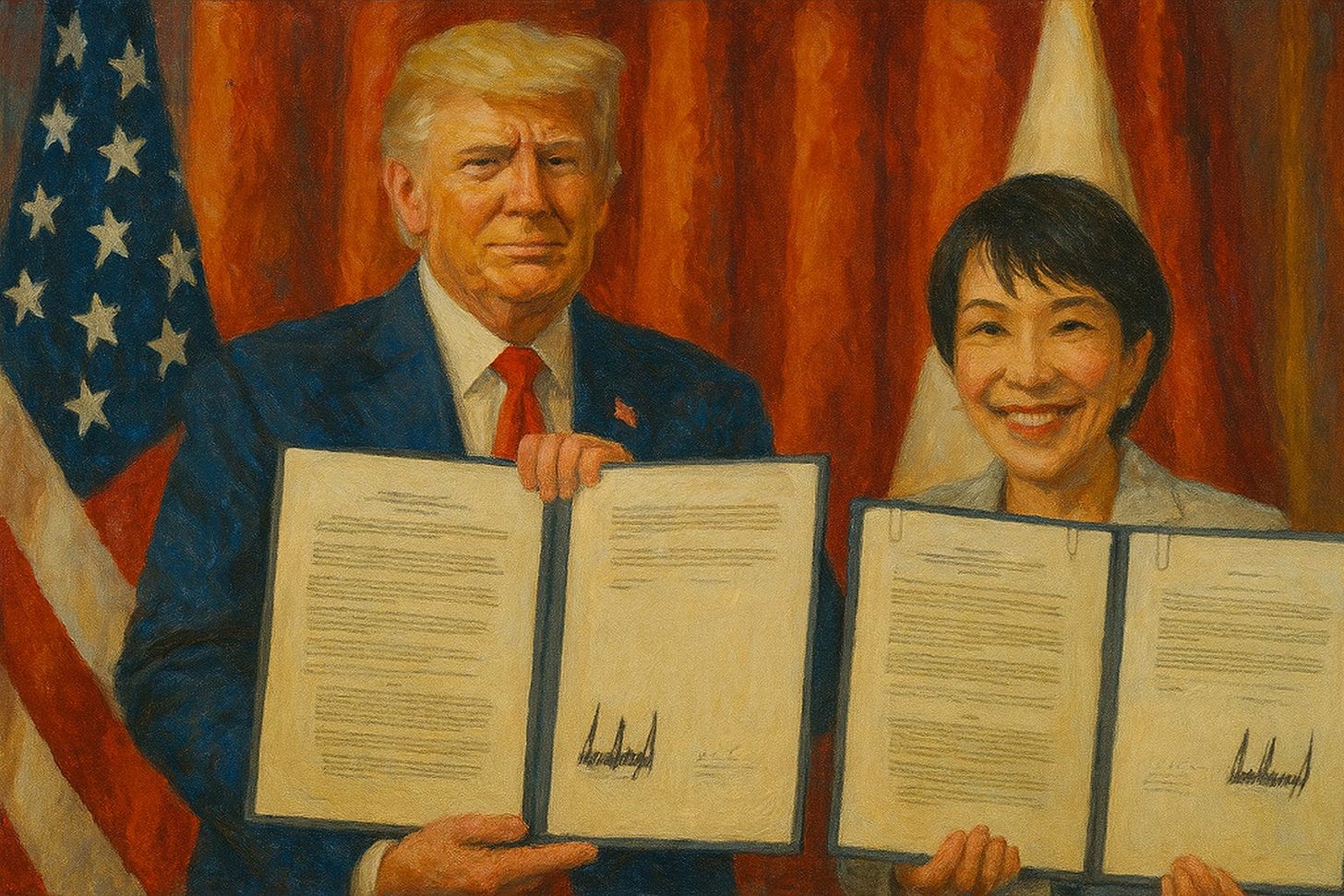America and Japan’s Golden Age, Enabled by China
An alliance built on the very supply chains it claims to escape.
October 28, 2025. Yokosuka Naval Base. A crowd of uniforms. A stage on the deck of the USS George Washington. Trump praised Japan’s new prime minister and called her a winner.
The real story sat in a single page almost no one will read.
The U.S.–Japan Framework for Securing the Supply of Critical Minerals and Rare Earths sounds like bureaucratic filler. It’s actually a bet sized at $550 billion that the West can loosen China’s grip on the materials behind everything from F-35s to phone speakers.
Announcement landed forty-eight hours before a meeting with Xi in South Korea.
Sanae Takaichi had been in office for seven days. Minority government. Fragile coalition. She needed a tangible result.
Japan’s first female PM arrived with the Abe halo, hoping the late mentor’s residue would grease the gears with a U.S. president who loves declarations of strength. The optics delivered: a shiny framework, flattering language, and a nomination for the Nobel Peace Prize for Trump, thanks to claims about Gaza and Cambodia involvement.
Japan got vows of unwavering support and a joint line about a NEW GOLDEN AGE of the alliance, complete with needy caps.
Strip away the ceremony and what’s left is transactional. Japan pledges $550 billion in U.S. investments. America offers security cover and market access. Both can tell domestic audiences they’re not chained to China for the stuff modern life runs on.
Here’s the uncomfortable truth about rare earths: not actually rare. Just miserable to process.
Seventeen elements. Complex metallurgy. Nasty waste. Big capital. Expertise that barely exists anymore in the West.
China saw the opening decades ago while the U.S. chased financial engineering. Today, Beijing processes more than 90 percent of global rare earths. Not the mining. The refining. That distinction matters. Ore is easy. Ultra-pure oxides and alloys are not. That’s the chokepoint.
When China curbs exports, it’s a warning shot. EVs stall. Wind turbines sit idle. The F-35 program feels a chill.
The framework promises to tackle the whole chain. Not just mines, but downstream processing. A Rapid Response Group that spins up within 24 hours during disruptions. Grants, guarantees, long-term offtake agreements, with initial decisions within six months.
Six months looks good in a press release. Building a rare earth refinery takes five to seven years. That means design, permits, construction, commissioning, and the ugly reality of handling caustic streams and toxic tailings. The six-month clock is politics. The seven-year clock is physics, chemistry, and local zoning boards.
Regulatory friction alone kills timelines. Environmental reviews. Water rights. Local opposition.
The framework pledges streamlining. So have previous plans. U.S. permitting doesn’t crawl because paperwork is fun. It crawls because communities do not want a solvent-soaked refinery in the neighborhood. Hard to blame them.
Cost structure is another anchor. New Western plants will face higher labor, higher compliance, and no legacy depreciation. Chinese facilities enjoy state support, scale, and looser rules. Dominance wasn’t an accident. Markets optimized for cheap today, not resilient tomorrow.
Then comes the bottleneck almost no one talks about: people. The West lacks metallurgists, chemical process veterans, and rare earth magnet specialists. China trained them for decades. The framework waves at money, not at talent. No muscular workforce program. No serious immigration channel for niche expertise.
Two days before meeting Xi, the message aimed at Beijing was clear enough: export controls are a wasting asset because alternatives are coming. Credibility is the question.
Calendars are legible. If refineries require five to seven years, vulnerability lasts until at least 2030. Incumbents with sunk costs and state backing win the price war. Western projects drown in permitting fights and election cycles.
Beijing doesn’t have to beat the framework. Just slow it down, raise the price, and let domestic politics do the rest.
The playbook exists. In 2015, when Molycorp tried to scale Mountain Pass, China flooded the market, prices collapsed, and Molycorp went bankrupt. The site revived under new ownership, but the lesson stuck. Nothing in this new framework shields projects from another price shock. Without defensible trade guardrails or guaranteed floor prices, allied producers are exposed.
So call it a golden age if the branding helps. The truth is uglier. This rush exists because Washington and Tokyo spent twenty years letting a rival corner the processing moat of a strategic industry.
The framework sets up committees, money pipes, and response cells. Useful, like emergency medicine is useful. It treats symptoms of a preventable condition.
This is a scramble from vulnerability, on a clock, at premium cost, with political stamina unproven over a seven-year grind.
Takaichi needed stability for a shaky government. Trump wanted leverage before sitting down with Xi. Both got the photo and the headline.
Results will be measured in plants that actually get built, engineers who actually run them, and commitments that actually survive the next cycle.
Check back in 2030. If American and Japanese processors are shipping competitive volumes, this will read as strategic foresight.
If not, chalk it up as an expensive ceremony dressed as industrial policy, signed by two leaders who needed a win and promised whatever it took to claim one.




Nobel Peace prize and Gaza don’t sit well in the same sentence at present.
Yup, that makes sense. Optics over factories.